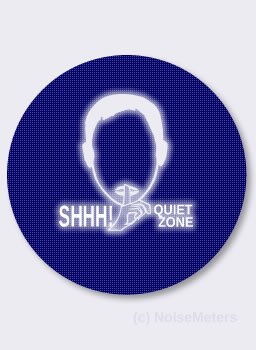


The delivery price is calculated during checkout based on your location and the goods ordered. Our basic delivery prices are:
Delivery within USA: $40.00
Delivery Service: Five working days*
* For products that are in stock and the order received by midday.
Some products go through a final configuration and calibration before being shipped. If the calibration labs are busy this can add up to two days on to the delivery schedule but guarantees a fresh calibration.
The NoiseSign is a wall-mounted sign that lights up when the noise levels are too high. It can be used to remind staff and visitors in hospitals, libraries and studying areas to keep their noise levels down.
The level at which the sign lights up can be set using controls on the back of the unit to anywhere between 40 and 114 dB(A) in 1 dB steps. It can be set to switch off immediately when the level falls, or to remain lit for 30 seconds. A small plate can be fitted over the controls to avoid tampering.
The Noise Sign is easily mounted to the wall using two screws, making it suitable for use on brick, wooden or plaster surfaces. It is lightweight so there is very little strain on the mountings.
Due to its very wide range of operation, 40 to 114 dB(A), the NoiseSign is suitable for most applications. In a hospital, school, or other quiet environment, it would usually be set somewhere in the region of 45 to 60 dB(A) as a reminder to people to keep the noise levels down.
For use in differing environments the brightness of the NoiseSign can be adjusted. In a bright area it would be set to its brightest, but for use in a hospital it might be set to a less intrusive level.
For environments where the sign might not be easily seen, up to three remote LED beacons can be attached. These beacons can be set to flash to make it clear that the noise levels are too high.
The NSB-RED and NSB-BLUE are low power, high visibility LED beacons that connect to the NoiseSign to give a clear warning of high noise levels. They light up at the same time the NoiseSign lights up.
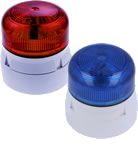
The noise beacon does not work on its own, it must be connected to the NS-QZON NoiseSign. You can connect one, two or three beacons to each noise warning sign.
The order code for the noise beacon is NSB-RED or NSB-BLUE, and this includes a 10 m (32 ft) cable to connect back to the NoiseSign or to daisy-chain to another beacon. The beacons get their power from the NoiseSign, so no extra power supply or power outlet is needed.
After completing a noise survey and working to reduce the noise at source, many industrial environments suffer with intermittently high noise levels. In such environments it may be unreasonable to ask staff to wear hearing protection at all times, so noise activated warning signs can be used to inform them when the levels are high.
One or more NoiseSigns can be mounted at strategic points, set to light up when the surrounding noise levels exceed 80 dB(A) for example.
The NoiseSign can be connected to an outdoor microphone system. The microphone is installed outside, connected to the sign that is mounted inside.
With this configuration staff can be warned of high sound levels outside (steam valves for example) that may cause complaints from local residents.
Music in pubs, clubs, discos and hotels tends to be of a certain volume to encourage the right atmosphere. However, some DJs and live groups can go a bit far, especially as the evening wears on and their hearing becomes dull, resulting in complaints from local residents.
The NoiseSign is the ideal way to keep the volume to a level agreed with the local residents or environmental health officer.
Noise in hospitals causes patient discomfort and can increase the recovery time. Much of the noise can be avoided if visitors and even staff are reminded of the issue. Noise activated signs mounted in the corridors or rooms are an excellent reminder.
The brightness level of the sign can be reduced for use in low-light areas where a bright sign would disturb.
Mounted in classrooms, communal areas and especially in cafeterias, the NoiseSign gives a very clear indication that the sound levels are too high.
In the classroom this makes for a much better learning environment. Elsewhere, it just makes it a more pleasant place to be for the majority who do not want too much noise.
Libraries are usually quiet places, but when people start chatting the noise levels can easily increase. It can be embarrassing to "Shhh" somebody at such times, so a sign that does it automatically is ideal.
The NoiseSign can be set to a very low level, lighting up when too much noise has been made, rather then when somebody else's perception suggests that it is too loud.
The NoiseSign, with the text SHHH! - Quiet Zone is the perfect reminder for staff and visitors that they should keep their noise levels down.
Typical locations for noise warning signs:
Just the presence of the NoiseSign is often reminder enough!
Too much noise in a hospital or medical center causes patient discomfort and can result in longer recovery times. The noise in question comes from visitors, staff, patients and from the movement of equipment. Noise Warning Signs take the strain out of reminding people to keep the noise levels down.
Unnecessary noise is the most cruel abuse of care which can be inflicted on either the sick or the well. Florence Nightingale, 1859.
Noise Signs are most popular in NICU and neonatal units, but are valuable on other general and intensive care units to remind not just the visitors but also the staff and patients to keep their noise levels down.
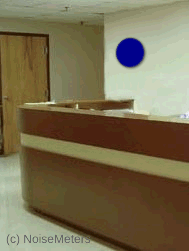
The perfect location for a sign depends on the layout and the acoustics of the area in question. The most important aspect of the NoiseSign is that it reminds people to keep the noise level down, so it is best to mount them where they are clearly visible to anybody entering the room or area. Often the Nurses Station is a good place to position one unit as this is in view to anybody visiting and also to constantly remind the staff.
There is no simple rule about the sound level trigger setting. Hospitals have different ambient noise levels and different acceptable limits. An intensive care unit will have a much lower noise threshold than a busy areas dealing with less critical illnesses. The best way to find the comfortable limit for an area is to set the sign up to 55 dB, run it for a few hours, or even a few days, and get a feel for whether it is being too sensitive for the given environment or whether it is letting people get away with too much. Adjust up or down by a few dB as needed. A level of 45 to 55 dB is common for neonatal and intensive care areas and 50 to 60 dB is common for other areas, although it does depend a lot on the acoustics of the areas in question.
Most of the noise warning signs that NoiseMeters supplies are for use in neonatal, and intensive care units. Babies in intensive care are particularly sensitive to high noise levels and to the increased stress that they cause.
Noise from visitors and staff is best dealt with using a device such as the NoiseSign as it is not influenced by the complicated human perception of noise. If it is loud, the sign will light up, whoever is making the noise.
Neonatal units, like most hospital environments, tend to be very poor acoustically due hard, reflective surfaces. Beds are often closely spaced, visitors can talk loudly (especially the younger ones) and staff have to work quickly and move equipment about. Add to this the incubators being opened and closed, occasional tapping on the lid and items dropped accidentally and the noise levels soon become unpleasant for the baby. One of the biggest culprits is the alarm, which is clearly essential, but as the background noise levels get higher the alarm has to be louder still. A quieter background allows for quieter alarms.
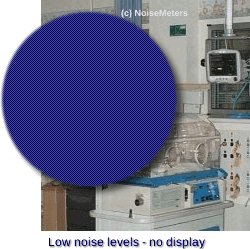
The immediate effects of noise in the neonatal unit are reasonably clear. The baby's sleep is easily disturbed and sudden loud noises (bangs on the incubator for example) can have a startling affect on the heart rate and breathing patterns.
High and intermittent noise is also unpleasant and distracting for both staff and parents. Defined "Quiet Times", when noise and light levels are kept down, certainly help and are now used in many units.
The long term effects of noise in the NICU are not so obvious. Hearing impairment as a result of exposure to high noise levels can be expected but research over the last few years has also shown a link with language development. This seems to be related to the fact that a baby that goes full term is only exposed to lower frequency noise (< 250 Hz) during the brain and sensory development stages.
Some such research can be found in the links below.
Mounted in classrooms, communal areas and especially in cafeterias, the NoiseSign gives a very clear indication that the sound levels are too high.
In the classroom this makes for a much better learning environment. Elsewhere, it just makes it a more pleasant place to be for the majority who do not want too much noise.
Libraries are usually quiet places, but when people start chatting the noise levels can easily increase. It can be embarrassing to "Shhh" somebody at such times, so a sign that does it automatically is ideal.
The NoiseSign can be set to a very low level, lighting up when too much noise has been made, rather then when somebody else's perception suggests that it is too loud.
The NoiseSign is very quick and easy to install:
The trigger level is adjustable between 40 and 114 dB(A) in 1 dB steps. The adjustment is made using controls that are usually out of site on the back of the unit.

The sign is fixed to the wall using the two screws and plugs that are included.
A paper template is also included in the box, accurately showing the distance needed between the holes.
Once the screws are in place the sign simply slides into place.

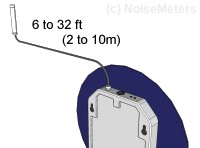
An optional microphone extension cable can be used to allow the microphone to be mounted up to 10 m from the sign.
The standard NoiseSign packages includes the following items:
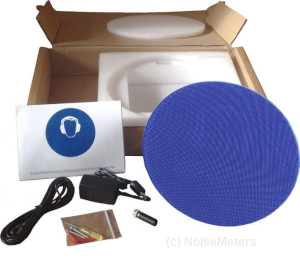
| NS-QZON | SHHH! QUIET ZONE |
| To remind staff and visitors to be quiet. Ideal for hospitals, libraries, schools and offices. |
| NSB-RED or | Beacon |
| NSB-BLUE | A low power, high visibility, weatherproof (IP65) beacon that connects to the NoiseSign. It lights up or flashes when the sound levels are too high. Up to three beacons can be connected to one sign. |
| Each beacon comes with 10 m (32 ft) of cable and simple wiring instructions. |
| NSR-QZON | The NoiseSign can be connected to up to three remote display signs. When the NoiseSign lights up, the remote signs light up in the same way and for the same period of time. Each remote unit comes with a 10 m cable to connect back to the master NoiseSign or between remote units. |
| NS-EX2 NS-EX5 NS-EX10 | The NoiseSign can be fitted with a remote microphone on a 2 m, 5 m or 10 m extension cable. To use this feature, a Class 2 microphone and preamplifier give the drive needed for the extension cable. |
A range of outdoor microphones is available for use with the NoiseSign. With the sign mounted indoors and connected to a microphone outside, an effective warning of high noise levels caused by industrial processes is provided. This configuration can also be useful for pub and clubs, giving a true warning when the sound levels at the boundary exceed a given limit.
Please contact NoiseMeters Limited for more details and pricing.
| Dimensions | 300 mm diameter, 50 mm deep |
| Trigger Level | 40 to 114 dB(A) in 1dB steps |
| Frequency Wgt | "A" Weighted to IEC 61672 |
| Time Wgt | Slow to IEC 61672 |
| Display | LED with variable brightness |
| Delay going off | None or 30 seconds |
| Power | 12 VDC (adapter included) |
| Output | Control for remote displays |
| Power | 11V, 50mA (Provided by the NoiseSign - no extra power needed) |
| Environmental | Weatherproof to IP65 |
| Case | Polycarbonate |
| Display | Selectable flashing or static |
| Flash Rate | 1Hz |
| Dimensions | Diameter: 85 mm Height: 81 mm |